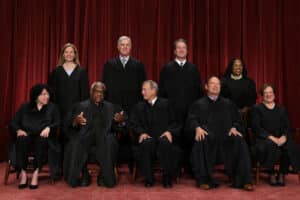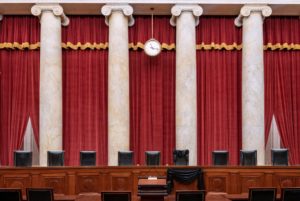Will this Supreme Court term turn out to be a bang or whimper?

Summer vacation is over for the Supreme Court. On October 7, the Justices will start hearing cases again in a term that is shaping up to be decidedly less exciting than the previous few. Whereas the Court has recently tackled hot-button issues ranging from racial preferences to abortion, the current docket mostly has to do with statutory interpretation questions—like how to interpret federal labor law and racketeering statutes. Still, four cases stand out as potential blockbusters.
In Garland v. VanDerStok, the Court will consider the Bureau of Alcohol, Tobacco, Firearms and Explosives’ (ATF) authority to regulate ghost guns—weapons that lack a serial number and that can be assembled at home using pre-made kits. In 2022, ATF deemed ghost guns “firearms” under a federal gun control law, meaning that sellers would have to secure a federal firearms license, keep sales records, and conduct background checks and that manufacturers would have to mark all ghost guns with a serial number. A group of plaintiffs sued on the basis that Congress did not include ghost guns in the definition of firearms, and a lower court agreed. Now, the Supreme Court will resolve the dispute.
Notably, the case does not involve the Second Amendment, and even if the plaintiffs prevail, Congress could always pass a new statute regulating ghost guns. But it’s still a big case to look out for given its near-term impact and because it involves a federal agency asserting broad power to regulate.
In United States v. Skrmetti, the Court will evaluate whether a Tennessee bill that prohibits gender-affirming care for minors violates the Equal Protection Clause. The law widely prohibits gender transition surgeries, puberty blockers, and hormone therapy for patients under 18, but permits those treatments for minors who need them for other purposes—for instance, because they started puberty too early. The plaintiffs — teenagers, their parents, and a doctor—argue that the law treats them differently than these other patients and deprives them of equal protection.
The Sixth Circuit upheld the law, noting the ongoing medical debate on this issue and largely deferring to the state’s authority to pass laws devoted to protecting minors. The legal question before the Supreme Court is what level of scrutiny judges should apply. Should they evaluate the law under a deferential standard of review? Or something stricter, given that it applies to transgender kids, who could be particularly vulnerable to discrimination?
Food and Drug Administration v. Wages and White Lion Investments involves vaping, the administrative state, and judicial review. In that case, the Food and Drug Administration denied a vaping company permission to market a new product, only for a federal court to set aside the FDA’s decision. According to the court, the FDA acted arbitrarily and capriciously and therefore contrary to federal law. Because the agency had offered different guidance at different times and told the company to submit a marketing plan but refused to even look at it, the court likened the FDA’s actions to “Romeo sending Mercutio on a wild goose chase—and then admitting there never was a goose while denying he even suggested the chase.” The case represents a broader trend of courts taking their power to review the actions of administrative agencies seriously.
Last, there’s Free Speech Coalition v. Paxton, which involves a Texas law that requires websites that contain more than 30 percent of material that is “harmful to minors” (i.e., pornography) to require age verification. A free speech coalition challenged the age verification requirement on the theory that it significantly affects adults and violates their First Amendment rights. According to the plaintiffs, the fact that most adults will balk at providing their personal information to these sites means that the law should be evaluated under strict First Amendment scrutiny rather than the more lax standard that usually applies to laws aimed at protecting children. What’s more, they say the law is both over- and underinclusive: it’s over-inclusive because it applies to websites even if a majority of the information is not harmful, and it’s underinclusive because it exempts search engines, where minors could gain access to pornographic material by using image searches. The lower court upheld the law, and now the Supreme Court will have the final say.
The Court still has many open slots on its docket and will add its first new batch of cases within the next few days. So, court-watchers must wait to see if this term proves as exciting as the last few.







